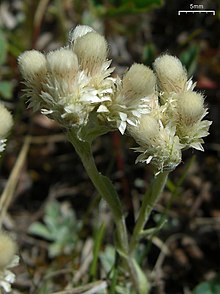| Antennaria parvifolia | |
|---|---|

| |
| Conservation status | |
 Secure (NatureServe) | |
| Scientific classification | |
| Kingdom: | Plantae |
| Clade: | Tracheophytes |
| Clade: | Angiosperms |
| Clade: | Eudicots |
| Clade: | Asterids |
| Order: | Asterales |
| Family: | Asteraceae |
| Genus: | Antennaria |
| Species: | A. parvifolia |
| Binomial name | |
| Antennaria parvifolia Nutt. | |
| Synonyms | |
Synonymy
| |
Antennaria parvifolia is a species of flowering plant in the family Asteraceae, known by the common names small-leaf pussytoes and Nuttall's pussytoes (not to be confused with littleleaf pussytoes). It is native to western and central North America.
Description
Antennaria parvifolia generally grows a few centimeters high but it may reach 15 cm (6 inches). The grayish, woolly-haired leaves are up to 3.5 cm (1+1⁄2 in) long, the upper ones shorter and narrower than the basal. The inflorescence contains 2 to 7 flower heads, each about 1.5 cm (1⁄2 in) across and blooming from July and September. The plant may be gynoecious, containing only female flowers, or dioecious, with some female plants and some male in a given population. Dioecious plants are most common in Colorado and New Mexico, and can reproduce sexually, though male plants are much less common than female. Plants in most other areas are mostly gynoecious, reproducing asexually via apomixis. The plant forms mats by spreading stolons and sprouting new stems. The flower heads are lined with an outer layer of phyllaries which are translucent except at the base, where they vary from white, red, green, and brown. The fruit is an achene with a pappus that helps it disperse on the wind.
Features that distinguish the species from other members of Antennaria include the clustered basal leaves and the near absence of dark bases on the backs of the flower bracts.
Distribution and habitat
The species is native to western and central North America and widespread in Canada, the United States, and northern Mexico—from British Columbia east to Ontario and south to California, Chihuahua, and Nuevo León. It has not been observed in California since 1987.
It can be found in open and dry areas such as plains and openings in forests.
Ecology
In Colorado, the species is an indicator of overgrazing and increases in frequency on heavily grazed land. It grows in disturbed habitat and a wide variety of ecosystems and soil types.
Cultivation
Some forms of the small-leaf pussytoes are considered excellent groundcovers, particularly by gardeners of the American great plains. They prefer to grow in the open in more northerly areas like North Dakota and at higher elevations, but prefer partial shade in more southerly locations such as Texas or lower altitudes. They are valued for their handsome foliage, their spring flowers, and for their lack of an aggressive nature in even the most ideal of garden conditions. They require a well drained soil, but may struggle in hot areas in sandy soils. They are cold hardy to USDA zones 4 (as cold as -34°C).
References
- NatureServe (2023). "Antennaria parvifolia Nuttall's Pussytoes". NatureServe Explorer. Arlington, Virginia: NatureServe. Retrieved 17 April 2023.
- The Plant List Antennaria parvifolia Nutt.
- ^ Spellenberg, Richard (2001) . National Audubon Society Field Guide to North American Wildflowers: Western Region (rev ed.). Knopf. pp. 354–355. ISBN 978-0-375-40233-3.
- ^ Antennaria parvifolia. Flora of North America.
- ^ Fryer, Janet L. 2011. (Revised from Matthews, Robin F. 1993.) Antennaria parvifolia. In: Fire Effects Information System, . U.S. Department of Agriculture, Forest Service, Rocky Mountain Research Station, Fire Sciences Laboratory.
- Antennaria parvifolia. USDA Plants Profile.
- Biota of North America Program 2014 county distribution map
- ^ Barr, Claude A. (1983). Jewels of the plains : wild flowers of the Great Plains grasslands and hills. Minneapolis: University of Minnesota Press. pp. 23–25. ISBN 0-8166-1127-0.
- DGB. "Antennaria parvifolia". Gardens Navigator. Denver Botanic Gardens. Retrieved 8 May 2023.
External links
 Data related to Antennaria parvifolia at Wikispecies
Data related to Antennaria parvifolia at Wikispecies Media related to Antennaria parvifolia at Wikimedia Commons
Media related to Antennaria parvifolia at Wikimedia Commons
| Taxon identifiers | |
|---|---|
| Antennaria parvifolia |
|
- NatureServe secure species
- Antennaria
- Plants described in 1841
- Flora of Northern America
- Flora of Canada
- Flora of Eastern Canada
- Flora of Ontario
- Flora of Western Canada
- Flora of Alberta
- Flora of British Columbia
- Flora of Manitoba
- Flora of Saskatchewan
- Flora of the United States
- Flora of the North-Central United States
- Flora of Kansas
- Flora of Nebraska
- Flora of Minnesota
- Flora of North Dakota
- Flora of Oklahoma
- Flora of South Dakota
- Flora of the Northeastern United States
- Flora of Michigan
- Flora of the Northwestern United States
- Flora of Colorado
- Flora of Idaho
- Flora of Montana
- Flora of Oregon
- Flora of Washington (state)
- Flora of Wyoming
- Flora of the Southwestern United States
- Flora of Arizona
- Flora of California
- Flora of Nevada
- Flora of Utah
- Flora of the South-Central United States
- Flora of New Mexico
- Flora of Texas